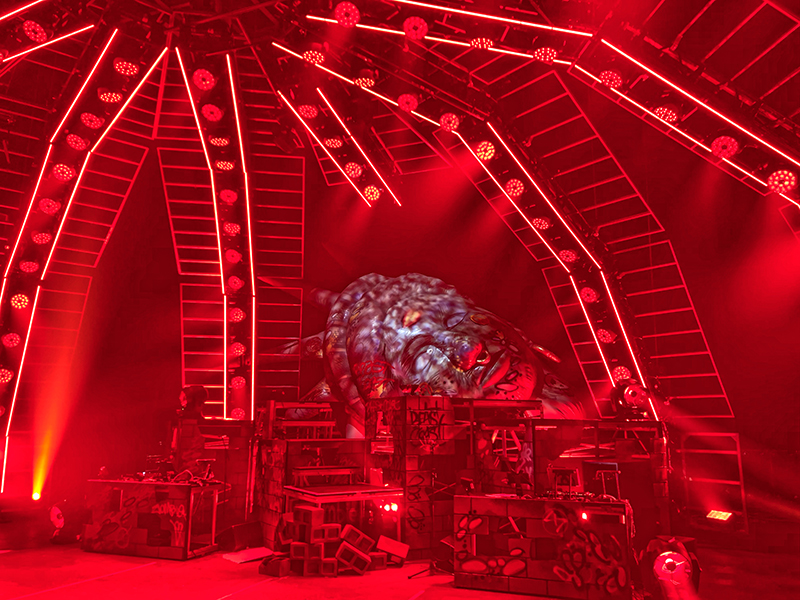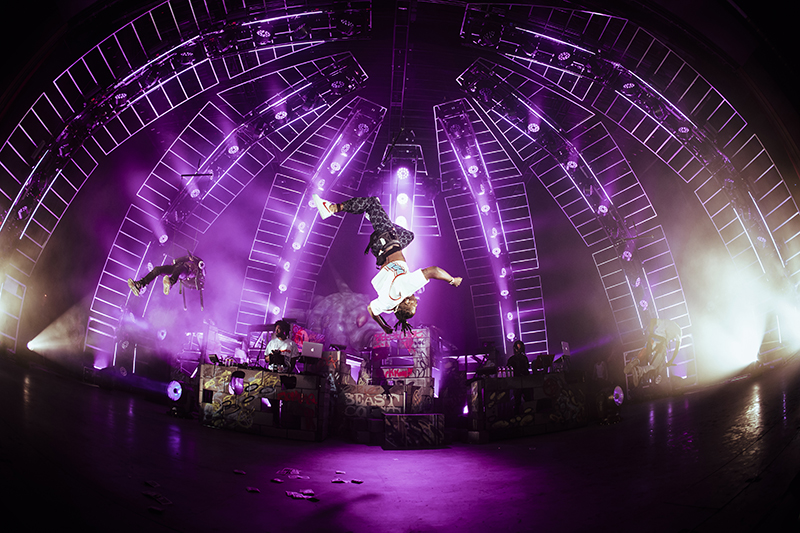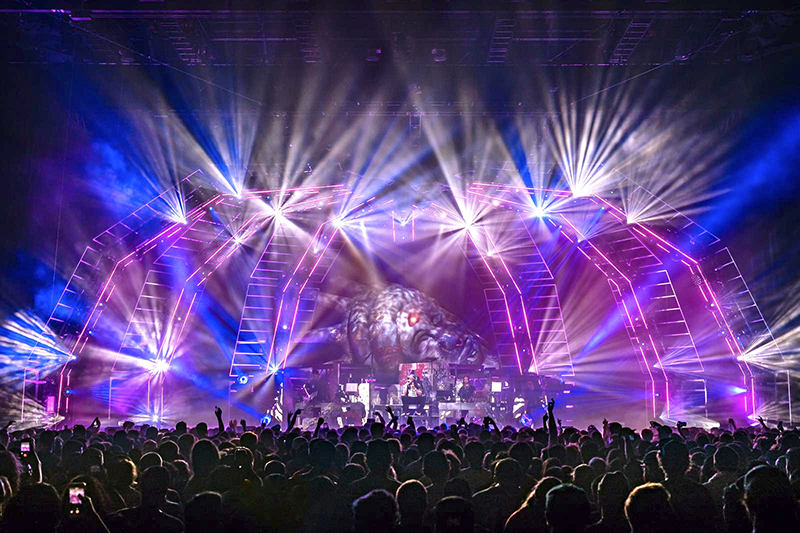
Noted hip-hop artists Joey Bad$$ and Flatbush Zombies, friends who grew up together in Brooklyn, joined forces to create Beast Coast in 2012. This year, they released their debut album, Escape From New York, and teamed up with The Underachievers, Kirk Knight, Nyck Caution, Powers Pleasant and CJ Fly on a month-long tour that shared its name with the album.
On their own tours, Beast Coast collective artists Joey Bad$$ and Flatbush Zombies tend to sell out 2,000-3,000 tickets each night. The combined draw of the two headliners and the other hip-hop talents, referred to as a “Rap Supergroup,” created a juggernaut, selling out large outdoor sheds and other venues around the U.S. The tour kicked off July 23 at Seattle’s WAMU Theater and wrapped up Aug. 25 at Baltimore’s MECU Pavilion.

If Beast Coast is best referred to, not as a band, but a collective, so is the team of creatives known as Mandylights. This collective of four designers, originating in Sydney, Australia but now with a base in the U.K. as well, was founded by director/designer Richard Neville. Banding together to offer clients more creativity, security and capacity than they could as freelancers, without the lumbering size of a full production company, the U.K. beachhead was established after a fortuitous meeting in Dubai between lighting designer Tom Edwards and the founder in 2016.
The first stages of the collaboration of these two collectives came about in 2017. “We’ve been working with Joey since that time,” says Edwards. “He happens to have the same management as Beast Coast. In January of this year, just after we finished up in Australia/New Zealand over New Years, Joey and I sat down to start discussing his next project at Red Rocks, that was coming up in April with Beast Coast.” That one-off served as a springboard for what would become the design for the Escape From New York Tour in July, Edwards notes.
The outline of the design brief given to Edwards was “Escape from New York” meets “Mad Max” meets “Post Apocalyptic New York.” The Beast Coast creatives wanted a set structure the artists could climb and interact with. The Mandylights design team proposed a “Thunder Dome”-themed design, with scalability to accommodate the varying size of the venues on the tour.

The Process
In the creative brainstorming sessions, the Mandylights team draws from all their diverse experiences with light artworks to theater to concert, dance parties and festivals. “The benefit with having four of us looking over designs is invaluable,” says Edwards, “We instantly have ideas coming to fruition, and the whole creative process is speeded up; which keeps us efficient in the rest of our projects.”
As for inspiration in his visual direction, Edwards feels very fortunate about having an intuitive ability to “be able to translate what I hear and feel into a visual representation to our shows,” adding that, “Social media plays a big part in design these days. The fact that there will be thousands of phones recording, streaming and posting away during our shows makes us very aware our visual direction needs to translate on phone cameras well.”
The steadfast design axiom “Form Follows Function” plays into the Mandylights design vision as well. “We all come from a background of practicality,” states Neville. “The Beast Coast set translates into huge features using existing Tyler truss and stage decks without resorting to huge custom builds. We’ve always done big things with existing products to keep budget in mind. Giving our artists as much as we can physically give them from a design perspective means we have to be really clever when designing a system that fits the requirements of the brief. First and foremost, it has to fit in the trucks we have been allocated, and scale in each venue so the identity to the show isn’t compromised.”

Lighting
“Our account manager at LMG was David Morris. David was awesome,” smiles Edwards, “he’s dealt with everything for us from finalizing kit lists to sitting through the endless rehearsal hours making sure we were happy while helping us make those final changes to the design. Their gear is all in perfect condition, and it’s safe to say we had zero failure rates on over 300 fixtures throughout the tour. It was a pleasure to work alongside all the touring crew who took this whole concept under their wing and worked tirelessly to deliver the design every day.”
The structure of the dome houses 100 Robe Spiiders. Essentially two fixtures in one, these supplied Edwards with consistent bright output of an array of elaborate pixel effects, tight washes and Robe’s proprietary pixel flower effect. Add to that fast action, precision of recalling positions , and a great zoom range one can see why Edwards says “these fixtures were the perfect selection for what was required.”

Martin VDO Sceptron 10 Linear LED video battens with 10mm pixel pitch lined each of the seven truss legs, complementing and highlighting the shape of the dome. The GLP JDC1 LED fixtures are the design team’s favorite strobe on the market for providing audience light along with a combination of bright color washes both in the house and the downstage edge.
“We needed a bright wash fixture that had the punch to command the set,” adds Edwards, so they selected TMB Solaris Flares. Robe MegaPointes provided a range of side light for spot and scenic dressing effects. Martin Axioms were used to light the giant 30-foot inflatable Statue of Liberty head. Edwards placed Philips VL6000’s and ColorBlasts as floor beams and up light for the artist flying moves. “We chose not to have any diffusion to maintain that ‘raw’ look.” he adds.
A noticeable creative point in the overall design was the decision not to use any video on the stage either. “We designed this show around the focal point of the artists,” explains Edwards. “We wanted the show to remain as intimate as possible for the audience without being distracted by a gap filling video treatment. We do make use of house I-Mag when the show tours through venues with them, because the venue size usually requires it.”
The show, which is extremely fast-paced, is run on timecode, as it contains over 1,200 cues, and there are more than 5,000 timecode events. “Hip-hop is a very intensive genre and deserves to have every hit accented in the programming,” says Edwards. “Show continuity is important for us too. It would be almost impossible for any operator to manually run this show.” Timecode also allows the operator to focus their attention to the hectic followspot call, as there are up to eight people on stage that require pickups for their verses and their fly cues.
The fly system was provided by ZFX Flying, operated by Wesley Miller. Three trusses with three fly points over the top of the thunder dome are required to fly the performers and give them access to climb the structure.
Mandylights’ team corporately plays the role of production and lighting designer. Their aim in the design of a show is to so tightly integrate the lighting and scenic aspects that the audience shouldn’t be able to tell which element came first. For that reason, they worked closely with Gallagher Staging who provided the riser formation, custom scenic frames, fascias and 30-foot-tall inflatable Liberty head.
Edwards and his fellow designers at Mandylights design, draw, render and program entirely in house. The majority of the show was programmed in their previz suite, followed by six days at ShowBiz studios in Los Angeles — a short distance from LMG’s L.A. facility. Two additional days in the first venue in Seattle were used to get the show perfect before opening night.
“We love getting involved with every aspect of a project,” Edwards says. “This helps transfer creative vision through all departments and allows us to have overall control with the outcome of the show.”
Working with a “Supergroup,” with essentially eight principals with multiple points of view, it would seem feedback might be a challenge. But “actually it was painless,” says Edwards. “The guys have a lot of trust invested in us. We’ve got a great relationship with the whole team so we all sat down during day one of rehearsals and came up with a set list, colors and specials. Then we were left to our own devices until the last day of rehearsals, where we received a final set of notes. The guys get really involved with their show on how it looks, feels and sounds. The biggest challenge for us was programming the 70 songs they could potentially pick from. Thankfully, the majority of the show was pre programmed in our Newcastle previz suite.”
Beast Coast Escape from New York Tour
Crew
- Production Designer: Richard Neville/Mandylights
- Lighting Designer: Tom Edwards/Mandylights
- Tour Lighting Director: Matthew Pallumbo
- Lighting/Rigging Co: LMG
- Lighting Crew Chief: Geoffrey McIntosh
- Lighting Techs: Peter Forster, Mikhal Sanchez, Leith Duvall
- Production Manager: Bobby Schneider
- Production Assistant: Andrea Espinoza
- Tour Manager: Mariko Jones
- Staging & Set Elements: Gallagher Staging
- Stage Manger: Scott Munn
- Rigger: Yader Mena
- Security: Lonnie Southall, Richard “DJ” Johnson
- Carpenters: Joe Bodner, Peter Will
- Fly System Vendor: ZFX Flying
- Fly Gag Maestro: Wesley Miller
Gear
- 2 grandMA2 Full consoles
- 100 Robe Spiiders
- 150 Martin VDO Sceptron 10’s
- 16 GLP JDC1 LED strobes
- 11 TMB Solaris Flares
- 6 Robe MegaPointes
- 4 Vari-Lite VL6000’s
- 12 ColorBlasts
- 4 Martin MAC Axioms


